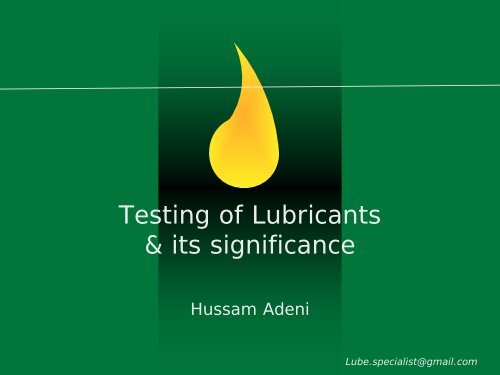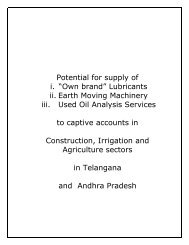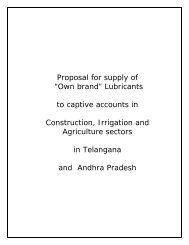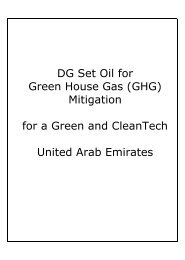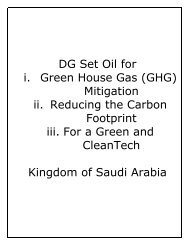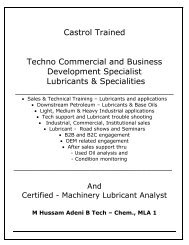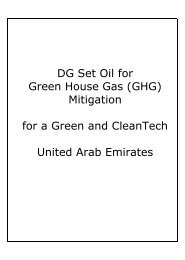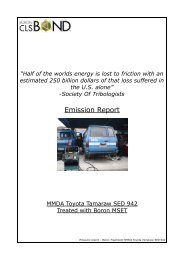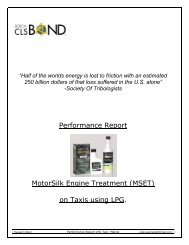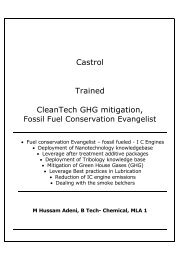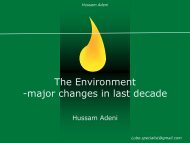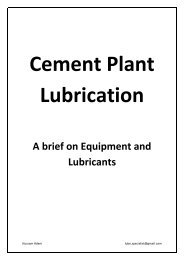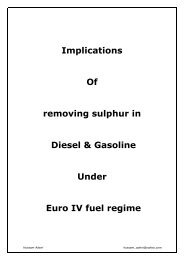Testing of Lubricants
Details of typical tests along with ASTM/IP numbers used for lubricants
Details of typical tests along with ASTM/IP numbers used for lubricants
You also want an ePaper? Increase the reach of your titles
YUMPU automatically turns print PDFs into web optimized ePapers that Google loves.
<strong>Testing</strong> <strong>of</strong> <strong>Lubricants</strong><br />
& its significance<br />
Hussam Adeni<br />
Lube.specialist@gmail.com
<strong>Testing</strong> <strong>of</strong> lubricants<br />
& its significance<br />
Type <strong>of</strong> lubricants<br />
Automotive <strong>Lubricants</strong><br />
Industrial lubricants<br />
Hussam Adeni<br />
Lube.specialist@gmail.com
<strong>Testing</strong> <strong>of</strong> lubricants<br />
& its significance<br />
Automotive <strong>Lubricants</strong><br />
• Engine Oils<br />
• Gear Oils<br />
• Brake Fluids<br />
• Coolants<br />
• Automatic Transmission Fluid<br />
Hussam Adeni<br />
Lube.specialist@gmail.com
<strong>Testing</strong> <strong>of</strong> lubricants<br />
& its significance<br />
Industrial <strong>Lubricants</strong><br />
• Metal working Oils<br />
• Neat, Soluble, Synthetic,<br />
• Semi synthetic<br />
• Metal Deformation<br />
• Heat Treatment<br />
• Corrosion Preventives<br />
• Dewatering Fluids<br />
• Industrial Cleaners<br />
• Compressor Oils<br />
Hussam Adeni<br />
Lube.specialist@gmail.com
<strong>Testing</strong> <strong>of</strong> lubricants<br />
& its significance<br />
Industrial <strong>Lubricants</strong><br />
• Hydraulic Fluids<br />
• Industrial Gear Oils<br />
• Turbine Oils<br />
• Refrigeration Oils<br />
• Greases<br />
• Rock Drill Oils<br />
• Electrical Oils<br />
• Process Oils<br />
• Ginning Oils<br />
Hussam Adeni<br />
Lube.specialist@gmail.com
Routine Lubricant tests<br />
Gear Oils<br />
• Color<br />
• Condition / Appearance<br />
• Acidity<br />
• Water content<br />
• Wear Metal Analysis (for used Oils)<br />
Hussam Adeni<br />
Lube.specialist@gmail.com
Routine Lubricant tests<br />
Turbine Oils<br />
• Color<br />
• Condition Appearance<br />
• Acidity<br />
• Water content<br />
• Kinematic Viscosity at 40 °C<br />
• Demulsification value<br />
• Wear Metal Analysis (for used Oils)<br />
Hussam Adeni<br />
Lube.specialist@gmail.com
Routine Lubricant tests<br />
Compressor Oils<br />
• Color<br />
• Condition Appearance<br />
• Acidity<br />
• Water content<br />
• Kinematic Viscosity at 40 °C<br />
• Wear Metal Analysis (for used Oils)<br />
Hussam Adeni<br />
Lube.specialist@gmail.com
Routine Lubricant tests<br />
Refrigeration Oils<br />
• Color<br />
• Pour /Floc point<br />
• Dielectric strength<br />
• Acidity<br />
• Water content<br />
• Kinematic Viscosity at 40 °C<br />
• Wear Metal Analysis (for used Oils)<br />
Hussam Adeni<br />
Lube.specialist@gmail.com
Common Lubricant tests<br />
Appearance<br />
• Fresh Oil is bright and clear<br />
• Presence <strong>of</strong> water or other contaminants make<br />
the oil hazy / cloudy<br />
Hussam Adeni<br />
Lube.specialist@gmail.com
Common Lubricant tests<br />
Density<br />
IP 160 /ASTM D 1298<br />
• Expressed as gm/cc<br />
• Measured at 15° C<br />
• Specific gravity ( or Relative density) is the<br />
density <strong>of</strong> the substance relative to density <strong>of</strong><br />
water<br />
Hussam Adeni<br />
Lube.specialist@gmail.com
Common Lubricant tests<br />
Colour<br />
ASTM D 1500<br />
• Expressed on scale <strong>of</strong> 0.0 to 8.0, latter being<br />
the darkest – Lovibond Colour Comparator.<br />
• Natural colour <strong>of</strong> lighter oils pale/yellow or<br />
darker for heavier (high Vis. Oils)<br />
• During usage and onset <strong>of</strong> oxidation, oil is<br />
darkened by products <strong>of</strong> combustion<br />
Hussam Adeni<br />
Lube.specialist@gmail.com
Common Lubricant tests<br />
Kinematic Viscosity (KV)<br />
IP 71 / ASTM D 445<br />
• Viscosity <strong>of</strong> a liquid is its resistance to flow &<br />
is directly related/affected by temperature<br />
• Viscosity decreases with increase in<br />
temperature & increases with decrease in<br />
temperature.<br />
• Kinematic Viscosity (KV) is expressed in<br />
centistokes (cSt)<br />
• ISO Viscosity grades KV @ 40° C and 100°C<br />
Hussam Adeni<br />
Lube.specialist@gmail.com
Common Lubricant tests<br />
Viscosity Index ( VI)<br />
IP 226 / ASTM D 2270<br />
• VI <strong>of</strong> an oil is calculated from its Kinematic<br />
viscosities at 40° C and 100°C<br />
• High VI – Oils exhibit small decrease in KV with<br />
increase in temperature<br />
• Low VI - Oils exhibit large decrease in KV with<br />
increase in temperature.<br />
• Paraffinic Oils – have high VI’s ( 80 – 100)<br />
• Naphthenic Oils – have low VI’s ( 0 – 30)<br />
Hussam Adeni<br />
Lube.specialist@gmail.com
Common Lubricant tests<br />
Flash Point (COC or PMCC)<br />
IP 34 / ASTM D 93, IP 36 / ASTM D 92<br />
• Lowest temperature at which a vapour above<br />
liquid will ignite when flame is applied<br />
• Expressed in Degrees Celsius (°C)<br />
• IP 34 – Pensky Marten Closed Cup (PMCC)<br />
• IP 36 – Clevland Open Cup ( COC)<br />
• Decrease on Flash Point – indicates thermal<br />
cracking <strong>of</strong> oil<br />
Hussam Adeni<br />
Lube.specialist@gmail.com
Common Lubricant tests<br />
Total Base Number (TBN)<br />
IP 276 / ASTM D 2896<br />
• Expressed as mgKOH/gm<br />
• It is the alkaline reserve incorporated into an<br />
oil to neutralize acid products <strong>of</strong> combustion<br />
derived from sulfur in the fuel.<br />
• TBN decrease result <strong>of</strong><br />
• Oil oxidation<br />
• Water contamination<br />
• Fuel contamination<br />
• TBN depletion can be reduced by oil ‘top up’<br />
Hussam Adeni<br />
Lube.specialist@gmail.com
Common Lubricant tests<br />
Copper Strip corrosion<br />
IP 154 / ASTM D 130<br />
• To evaluate corrosive properties <strong>of</strong> oil.<br />
• Particular significance to Gear Oils<br />
Hussam Adeni<br />
Lube.specialist@gmail.com
Common Lubricant tests<br />
Dielectric Strength<br />
ASTM D877 ( Up to 230 kV)<br />
ASTM 1816 ( Higher voltages)<br />
• Measures resistivity between two electrodes.<br />
• Particularly for Transformer oils.<br />
• Dielectric Strength, drops / fails due to<br />
contamination, dust, dirt, moisture, etc..<br />
• Also for refrigeration Oils for hermetically<br />
sealed compressors<br />
Hussam Adeni<br />
Lube.specialist@gmail.com
Common Lubricant tests<br />
Foaming characteristics<br />
IP 146 / ASTM D 892<br />
• Generally due to contamination with surface<br />
active materials.<br />
• Excessively high flow rates.<br />
• Depletion <strong>of</strong> anti foaming additive package<br />
• May result in cavitation, pressure drop,<br />
intermittent flow / circulation.<br />
Hussam Adeni<br />
Lube.specialist@gmail.com
Common Lubricant tests<br />
Pour point<br />
IP 15 / ASTM D 97<br />
• An indicator <strong>of</strong> the flow properties <strong>of</strong> oils at<br />
low temperature.<br />
• Crystallization <strong>of</strong> waxy components at low<br />
temperature restricts the flow <strong>of</strong> oil an d<br />
results in oil starvation.<br />
Hussam Adeni<br />
Lube.specialist@gmail.com
Common Lubricant tests<br />
Acidity (TAN)<br />
IP 177:96 / ASTM D 664<br />
• Expressed as mgKOH/gm<br />
• Measures - total acidity <strong>of</strong> the oil i.e. presence<br />
<strong>of</strong> strong inorganic and weak organic acids<br />
• Increase <strong>of</strong> TAN indicates<br />
• Hydrolysis <strong>of</strong> oil<br />
• Oxidation<br />
• Contamination<br />
• High TAN values can lead to problem <strong>of</strong><br />
corrosion.<br />
Hussam Adeni<br />
Lube.specialist@gmail.com
Common Lubricant tests<br />
Water content<br />
IP 356 (KF) / ASTM D 1744 & 4377<br />
• Measures extend <strong>of</strong> water contamination<br />
• In general “no water” should be present in<br />
lubricating oil ( Max tolerated is 0.2%)<br />
• Salt water contamination (Marine grades) may be<br />
traced to cooler leakages, ship’s hull etc..<br />
• Common metals in sea water include<br />
• Sodium 11,000 ppm, Calcium 400 ppm,<br />
• Magnesium 1,300, Potassium 400 ppm<br />
Hussam Adeni<br />
Lube.specialist@gmail.com
Common Lubricant tests<br />
Total insolubles<br />
IP 316 / ASTM D 893<br />
• Total amount <strong>of</strong> extraneous matter which are<br />
derived from products <strong>of</strong> combustion<br />
• Includes burnt lubricating oil and additive ash,<br />
rust, salt, wear debris and abrasive matter. (IP<br />
method deploys high RPM centrifuge +10,000 g, preferred for<br />
dispersant/detergent additives lube oils- ASTM D893 is 600 – 700 g)<br />
• Viscosity <strong>of</strong> an oil increase with increase in the<br />
level <strong>of</strong> total insolubles.<br />
• Expressed as % <strong>of</strong> the quantity <strong>of</strong> oil.<br />
Hussam Adeni<br />
Lube.specialist@gmail.com
Common Lubricant tests - others<br />
Additional tests commonly referred to:<br />
• Thermal stability<br />
• Detergency<br />
• Dispersancy<br />
• Anti wear Tests<br />
• Timken OK load<br />
• Four ball wear<br />
• Grease consistency<br />
Hussam Adeni<br />
Lube.specialist@gmail.com
Special Lubricant tests<br />
- For used oils<br />
Conducted on sophisticated equipment<br />
for premium lubricants<br />
• Elemental analysis<br />
• Wear metal analysis (Particle size 0.1 – 1000<br />
microns)<br />
• ICP – Inductively Coupled Plasma Spectra photometer<br />
• Larger, expensive to buy and maintain, good for R&D<br />
• Atomic absorption Spectra (AAS)<br />
• Is simpler , smaller & compact<br />
• Ferrography (Generally larger particles 10 to 1000 micron)<br />
• Viewed under high powered microscope, biased to Ferric,<br />
Hussam Adeni<br />
Lube.specialist@gmail.com
Special Lubricant tests –<br />
- Base oils and raw materials<br />
Conducted on sophisticated equipment<br />
for premium lubricants<br />
• Fourier Transform Infra Red Spectroscopy (FITR)<br />
• Differential Scanning Calorimeter (DSC)<br />
• Oxidation onset Temperature (OOT)<br />
• Gel Permeation Chromatography (GCP)<br />
• Gas Chromatography (GC)<br />
Hussam Adeni<br />
Lube.specialist@gmail.com
Special Lubricant tests<br />
– Wear metal analysis – Used oils<br />
ICP / Atomic Absorption Spectra (AAS)<br />
Wear metals may include some <strong>of</strong> the following<br />
• Aluminum Pistons, Bearings<br />
• ChromiumCylinder liner, Piston rings etc..<br />
• Copper Bearings, Coolers<br />
• Iron Crankshaft, Gearing, Piston rings<br />
• Lead Bearings<br />
• Manganese Steel components<br />
• Nickel Pistons rings, steel components<br />
• Silver & Tin Bearings<br />
• Molybdenum Piston rings<br />
Hussam Adeni<br />
Lube.specialist@gmail.com
Special Lubricant tests<br />
Elemental analysis – Used Oils<br />
ICP / Atomic Absorption Spectra (AAS)<br />
Elements commonly found in lubricants include<br />
• Zinc, Phosphorus Anti wear package (ZDDP)<br />
• Sulphur Base Oil, additives<br />
• Sulphur Gear Oil additive<br />
• Magnesium Rust inhibitors<br />
• Barium Rust inhibitors<br />
• Silicon Antifoam<br />
• Calcium, Detergents<br />
• Magnesium Detergents<br />
• Boron Dispersants<br />
Hussam Adeni<br />
Lube.specialist@gmail.com
Special Analytical Tests<br />
FTIR – for Base Oils & raw material<br />
Fourier Transform Infra red Spectroscopy<br />
• FTIR generates a spectrum which is then used to<br />
confirm the presence <strong>of</strong> a particular bond (Single<br />
bond, double bond etc..)<br />
• Used to determine paraffinic, aromatic and<br />
naphthenic content in mineral oils<br />
• To identify functional groups like esters, aromatics,<br />
amide, etc..<br />
Hussam Adeni<br />
Lube.specialist@gmail.com
Special Analytical Tests<br />
- for Base oils and raw materials<br />
Differential Scanning Calorimeter - DSC<br />
• Monitoring a particular property <strong>of</strong> the oil under<br />
isothermal conditions with time.<br />
• Thermograms generated by this technique are<br />
“Finger prints” <strong>of</strong> the material/ oil.<br />
• DSC is used to determine OOT (Oxidation onset<br />
temperature), OIT (Oxidation Induction Time and<br />
smoke content<br />
Hussam Adeni<br />
Lube.specialist@gmail.com
Special Analytical Tests<br />
- for Base oils and raw materials<br />
Oxidation onset Temperature (OOT)<br />
• Temperature at which oxidation <strong>of</strong> the oil begins<br />
under controlled conditions (PDSC cell)<br />
• Characterized by peak due to heat <strong>of</strong> the reaction <strong>of</strong><br />
oxidation.<br />
• Useful in deciding the working range <strong>of</strong> the oil<br />
Hussam Adeni<br />
Lube.specialist@gmail.com
Special Analytical Tests<br />
- for Base oils and raw materials<br />
Gel Permeation Chromatography- GPC<br />
• Sample passes through a column with liquid where<br />
various components are absorbed. depending on<br />
their molecular weight<br />
• Used to determine molecular weight <strong>of</strong> polymers by<br />
comparing with standard polymer <strong>of</strong> known<br />
molecular weight<br />
Hussam Adeni<br />
Lube.specialist@gmail.com
Special Analytical Tests<br />
- for Base oils and raw materials<br />
Gas Chromatography- GC<br />
• Sample passes through a column with a carrier gas<br />
where various components are absorbed depending<br />
on the temperatures <strong>of</strong> the column, packing<br />
materials etc.<br />
• Used to determine purity and percentage <strong>of</strong> various<br />
components present in a mixture.<br />
• Mainly used for raw material analysis<br />
Hussam Adeni<br />
Lube.specialist@gmail.com
Thank you<br />
Hussam Adeni<br />
Lube.specialist@gmail.com


